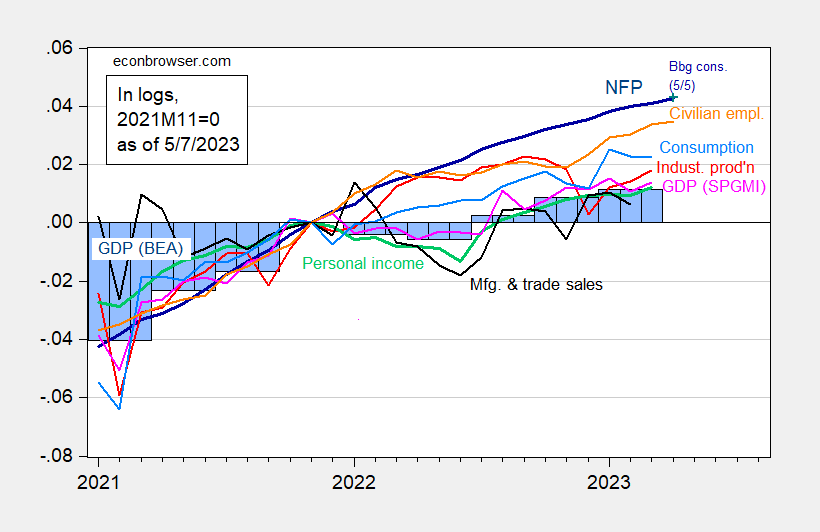With the employment release, showing a deceleration in employment growth despite the upside surprise in April’s number, this is the picture of the series the NBER Business Cycle Dating Committee (BCDC), plus monthly GDP from S&P Global Market Intelligence (SPGMI) formerly Macroeconomic Advisers.
Figure 1: Nonfarm payroll employment, NFP (dark blue), Bloomberg consensus of 5/5 (blue +), civilian employment (orange), industrial production (red), personal income excluding transfers in Ch.2012$ (green), manufacturing and trade sales in Ch.2012$ (black), consumption in Ch.2012$ (light blue), and monthly GDP in Ch.2012$ (pink), GDP (blue bars), all log normalized to 2021M11=0. Bloomberg consensus level calculated by adding forecasted change to previous unrevised level of employment available at time of forecast. Source: BLS, Federal Reserve, BEA 2023Q1 advance release via FRED, S&P Global/IHS Markit (nee Macroeconomic Advisers, IHS Markit) (5/1/2023 release), and author’s calculations.
As noted in this post, the actual level of employment is below the implied Bloomberg level, despite the outsized reported change, because of the downward revisions to previous months. The important point is that, as shown by the flattening slope, employment growth is declining. This is true across several indicators of employment.
Figure 2: Nonfarm payroll employment from April 2023 CES release (blue), household series adjusted to NFP concept (green), QCEW total covered workers, seasonally adjusted using log transformed Census X-13 (tan), using multiplicative moving average (sky blue), Philadelphia Fed preliminary benchmark (pink squares), all in 000’s, s.a, all on log scale. Source: BLS via FRED, BLS, BLS QCEW, Philadelphia Fed, and author’s calculations.
Keeping in mind the data will be revised, there is no obvious sign of recession by 2023M04 — nor a recession having occurred in 2022H1 as some have speculated.


“Keeping in mind the data will be revised, there is no obvious sign of recession by 2023M04 — nor a recession having occurred in 2022H1 as some have speculated.”
I just had to. Yes – I checked the latest on Vehicle Miles Traveled. Way up in January 2023 but then VMT fell in Feb. 2023. OH NO! RECESSION! Oh wait – my TV switched from the NBA game to Faux News. Where’s that remote?
https://english.news.cn/20230501/27989589254a4339aa0f08f092ba577e/c.html
May 1, 2023
Chinese experts imparting rice-growing technology in Dominican Republic
A team of Chinese experts is imparting China’s rice-growing technology in the Dominican Republic to help the country improve the yield and quality of rice.
SANTO DOMINGO — A team of Chinese experts is imparting China’s rice-growing technology in the Dominican Republic to help the country improve the yield and quality of rice.
Since October, the three-member team has been experimenting on 1.3 hectares of land provided by the Dominican National Rice Training Center in Banao, a town some 80 km northeast of the capital Santo Domingo.
The initiative is part of a cooperation project between the department of agriculture and rural affairs of central China’s Hunan province and the Dominican Agriculture Ministry’s department of international cooperation.
“We have selected five local varieties of rice for field cultivation, and those varieties have entered the binding and uprooting stage,” Chinese agricultural expert Yu Yunxiang told Xinhua.
The resulting crop, said Yu, will be studied to analyze the state of rice output and growth in a tropical country with abundant rainfall, heat, flat terrain and fertile soil, which are favorable natural conditions for rice-growing with great production potential.
Meanwhile, high temperatures and humidity make crops prone to pests and diseases, so more observation and research into potential solutions are needed, he added.
“Starting in June, we are going to select from 18 Chinese hybrid rice varieties, five high-yield, high-quality and stress-resistant ones that will be used for demonstration in two paddy fields of about 6.6 hectares,” said Yu.
The seeds to be planted in these fields were specially brought from Hunan, the cradle of Chinese hybrid rice and one of the first Chinese provinces to develop cooperation projects with the Dominican Republic after diplomatic relations were established on May 1, 2018.
Agricultural machinery and equipment from China will also be used, along with planting technology that should help the country improve its level of mechanized production, and prevent and control diseases and pests that harm agricultural production.
“We expect the average yield of demo varieties to increase by 25 percent compared to local varieties,” Yu said.
Agricultural cooperation is expected to go beyond rice to include premium Chinese vegetables to be planted in other parts of the Dominican Republic.
The goal is to promote cultivation techniques for these high-yield vegetables in greenhouses to raise local production levels and help the Caribbean country earn more foreign revenue by exporting agricultural goods….
Pavlov would be so proud. Mention China’s poor rice crop and ltr copy/pastes full articles of Chinese rice propaganda.
World production of rice is approximately 750 million metric tons per year. China produces about 30% of that but China also consumes about 30% of the world’s rice.
Dominican Republic produces only 0.1% of the world’s production but this more than enough for its rice consumption.
It is nice that the Chinese are helping the Dominican Republic but here’s the Global South question. Is China charging the Dominican Republic for the use of its know how?
“The Dominican Republic is self-sufficient in rice production, with an average annual output of approximately 600,000 tons produced by some 300,000 farmers”.
That is consistent with my sources on rice production by nation. So if the typical farmer produces 2 tons of rice per year, does anyone know how this translate into his income?
https://fred.stlouisfed.org/graph/?g=ToHJ
August 4, 2014
Real per capita Gross Domestic Product for Dominican Republic, Chile and China, 1971-2021
(Percent change)
https://fred.stlouisfed.org/graph/?g=ToHN
August 4, 2014
Real per capita Gross Domestic Product for Dominican Republic, Chile and China, 1971-2021
(Indexed to 1971)
[ Dominican Republic has experienced faster per capita growth than any country in the hemisphere since 1971. ]